
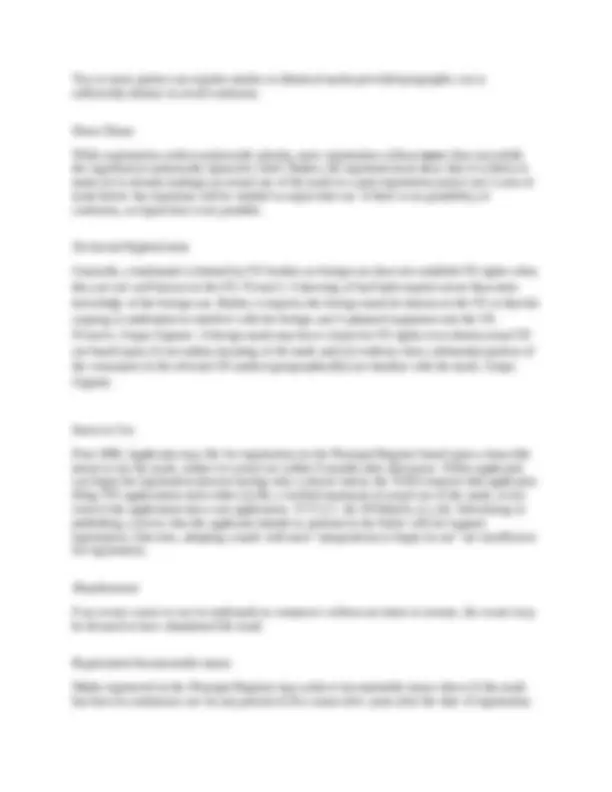
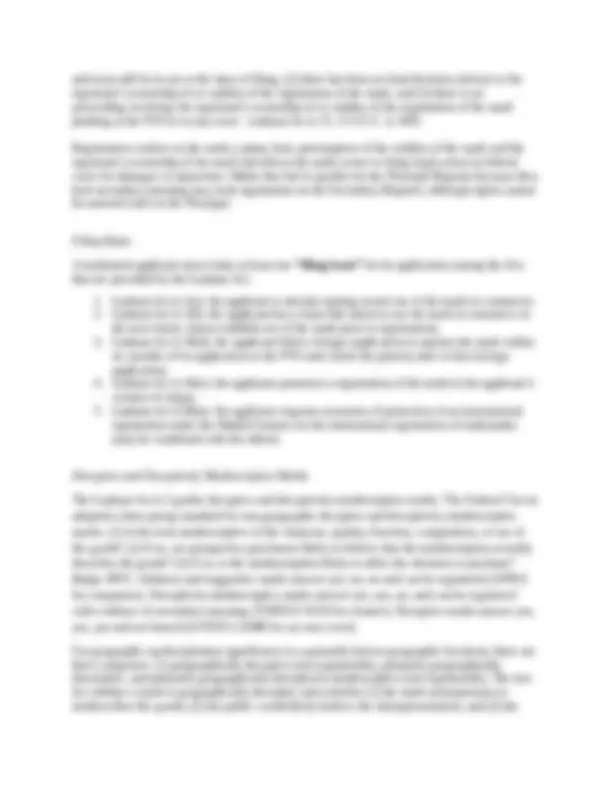
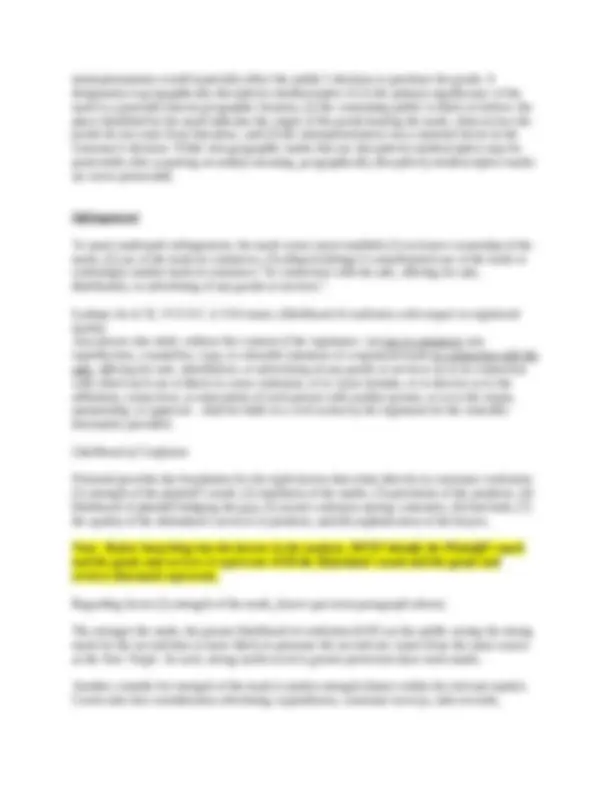
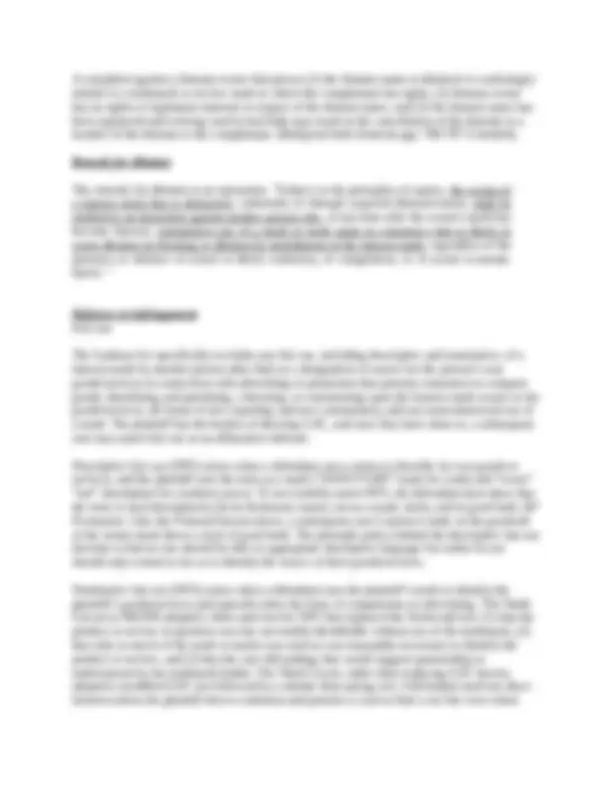
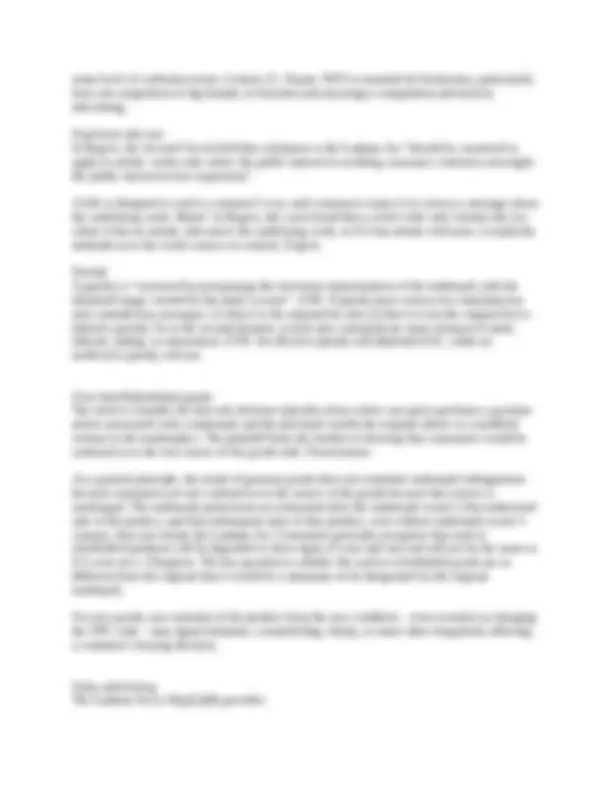
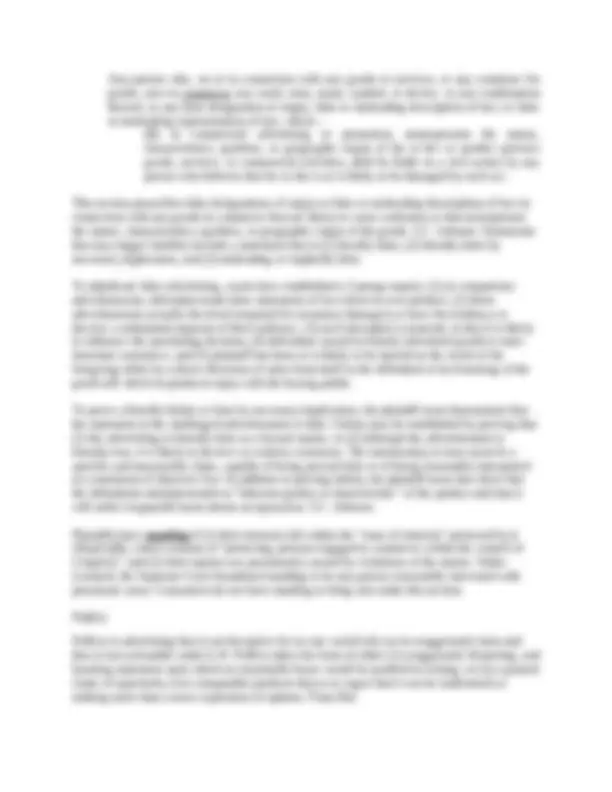


Study with the several resources on Docsity

Earn points by helping other students or get them with a premium plan


Prepare for your exams
Study with the several resources on Docsity

Earn points to download
Earn points by helping other students or get them with a premium plan
Community
Ask the community for help and clear up your study doubts
Discover the best universities in your country according to Docsity users
Free resources
Download our free guides on studying techniques, anxiety management strategies, and thesis advice from Docsity tutors
An overview of key concepts in trademark law, including the spectrum of distinctiveness, the requirements for trademark use in commerce, the concept of concurrent use, the process of obtaining incontestable status for a registered mark, and the factors considered in determining trademark infringement and dilution. It covers topics such as the different categories of marks (fanciful, arbitrary, suggestive, descriptive), the role of secondary meaning, the standards for establishing use in commerce, the requirements for achieving incontestable status, and the multifactor tests for likelihood of confusion and dilution. The document also discusses various defenses to infringement, such as fair use and false advertising. This comprehensive coverage of trademark fundamentals would be valuable for students studying intellectual property law, marketing, or business strategy.
Typology: Study notes
1 / 11

This page cannot be seen from the preview
Don't miss anything!







What is a trademark? Rule A trademark is any word, name, symbol, or device, or any combination thereof used by a person to identify and distinguish his or her goods or services from those of others and to indicate the source. Lanham Act § 45. The mark informs consumers that a certain product or service is from the same source, and consumers rely on the mark to assist them in determining which product or service to buy (or not buy). To many consumers, the mark is not just a source indicator but also a status symbol – conveying, for example, social status. To be a valid trademark, it must (1) identify the source of the goods/services sold under the designation, (2) be distinctive of the source (either inherent or acquired), (3) not be disqualified due to statutory bars (for example, comprising a flag or coat of arms), (4) not be functional, and (5) used in commerce. The mark does not need to be registered or used in a particular form, but a registered mark provides greater protection and remedies than an unregistered mark. Distinctiveness The Spectrum of Distinctiveness as provided by Abercrombie provides 5 categories relevant for determining the distinctiveness of word, symbol, or phrase marks. Fanciful marks are invented words, symbols, or phrases (such as Kodak) that have no other meaning than as the mark and are the most protectable. Next, arbitrary marks are a common word, symbol, or phrase that is used in an unrelated context (such as Apple for computers or Amazon for logistics). Suggestive marks hint at an attribute of the product or service but require the consumer to take an imaginary mental leap (such as Dairy Queen for ice cream). Descriptive marks reflect the nature, quality, or contents of the product/service (such as Associated Press) and are only protectable with secondary meaning. To determine whether a mark is suggestive or descriptive, Zatarain’s provides a 4-factor test: dictionary definition, imagination, competitor’s need for use, and use by others. Finally, a generic mark is one that refers to or has come to be understood as referring to the genus of which the particular product is associated (Aspirin (genericide), “Beer” for beer) and cannot be protected. A mark is inherently distinctive when consumers perceive it as a designation of source based on the nature of the product/service and the context of its use. If not inherently distinctive, a mark may acquire distinctiveness (secondary meaning) as a result of its use in so far as consumers have come to perceive it as a designation of the source of the goods/services. Inwood. Arbitrary, fanciful, and suggestive marks are considered inherently distinctive and do not need a showing of secondary meaning, whereas descriptive marks are. Notably, product color or design are never inherently distinctive; it must acquire distinctiveness through secondary meaning. The color/design must act as a mark and not merely perceived as ornamentation. Qualitex; Walmart; Lululemon. Functionality
The functionality doctrine prevents trademark law from inhibiting legitimate competition through the control or monopolization of a useful product feature. Qualitex; Kellogg. Inwood provides a two-pronged test to determine whether a product feature is functional (and thus not protectable): (1) if it is essential to the use or purpose of the article or (2) affects the cost or quality of the article. Traffix ; Morton-Norwich. When expressing functionality, the court is referencing the utility of the design of the thing not the thing itself. Morton-Norwich. A feature is essential if it is dictated by the functions performed. A court may also consider evidence of functionality through a utility patent disclosing utilitarian advantages, utilitarian advantages expressed in advertising or packaging, availability of other designs, and evidence of manufacturing advantages. Characteristics having aesthetic functionality convey a competitive advantage that cannot be duplicated by the use of other marks (“red and green” for December holiday items, hearts for Valentine’s day; distinguished from the gold-green laundry pad of Qualitex or pink insulation). A characteristic has utilitarian functionality when it affects the cost or tangible quality of the product (plumeria scented thread distinguished from Traffix’s spring). If there are more than a limited range of alternative designs available to competitors such that monopolization of the feature would not place competitors at a significant non-reputation related disadvantage, then the feature is not functional. However, if an ornamental feature would significantly hinder competition by limiting the range of adequate alternative designs, the functionality doctrine denies protection. Wallace. Use in Commerce The US trademark system is a “use” based system, which ensures that the regime stays within the Congress’s Commerce Clause powers and actual use is a generally a prerequisite for obtaining common law trademark rights protectable under § 43. Actual or constructive use or activity overseas may provide a basis for filing an application for the Principal Register, and “use in commerce” encompasses all commerce that may be lawfully regulated by Congress. Lanham Act § 45, 15 U.S.C. § 1127 A mark shall be deemed to be in used in commerce when: (1) on goods when-- (A) it is placed in any manner on the goods or their containers or the displays associated therewith or on the tags or labels affixed thereto, or if the nature of the goods makes such placement impracticable, then on documents associated with the goods or their sale, and (B) the goods are sold or transported in commerce, and (2) on services when it is used or displayed in the sale or advertising of services and the services are rendered in commerce, or the services are rendered in more than one State or in the United States and a foreign country and the person rendering the services is engaged in commerce in connection with the services. Concurrent Use
and must still be in use at the time of filing, (2) there has been no final decision adverse to the registrant’s ownership of or validity of the registration of the mark, and (3) there is no proceeding involving the registrant’s ownership of or validity of the registration of the mark pending at the PTO or in any court. Lanham Act § 15, 15 U.S.C. § 1065. Registration confers on the mark a prima facie presumption of the validity of the mark and the registrant’s ownership of the mark and allows the mark owner to bring legal action in federal court for damages or injunction. Marks that fail to qualify for the Principal Register because they lack secondary meaning may seek registration on the Secondary Register, although rights cannot be asserted until on the Principal. Filing Basis A trademark applicant must claim at least one “filing basis” for its application among the five that are provided by the Lanham Act:
misrepresentation would materially affect the public’s decision to purchase the goods. A designation is geographically deceptively misdescriptive if (1) the primary significance of the mark is a generally known geographic location, (2) the consuming public is likely to believe the place identified by the mark indicates the origin of the goods bearing the mark, when in fact the goods do not come from that place, and (3) the misrepresentation was a material factor in the consumer's decision. While non-geographic marks that are deceptively misdescriptive may be protectable after acquiring secondary meaning, geographically deceptively misdescriptive marks are never protectable. Infringement To assert trademark infringement, the mark owner must establish (1) exclusive ownership of the mark, (2) use of the mark in commerce, (3) alleged infringer’s unauthorized use of the mark or confusingly similar mark in commerce “in connection with the sale, offering for sale, distribution, or advertising of any goods or services ”. Lanham Act § 32, 15 U.S.C. § 1114 states: (likelihood of confusion with respect to registered marks) Any person who shall, without the consent of the registrant-- (a) use in commerce any reproduction, counterfeit, copy, or colorable imitation of a registered mark in connection with the sale, offering for sale, distribution, or advertising of any goods or services on or in connection with which such use is likely to cause confusion, or to cause mistake, or to deceive as to the affiliation, connection, or association of such person with another person, or as to the origin, sponsorship, or approval…shall be liable in a civil action by the registrant for the remedies hereinafter provided. Likelihood of Confusion Polaroid provides the foundation for the eight factors that relate directly to consumer confusion: (1) strength of the plaintiff’s mark, (2) similarity of the marks, (3) proximity of the products, (4) likelihood of plaintiff bridging the gap, (5) actual confusion among customers, (6) bad faith, (7) the quality of the defendant’s services or products, and (8) sophistication of the buyers. Note: Before launching into the factors in the analysis, MUST identify the Plaintiff’s mark and the goods and services it represents AND the Defendant’s mark and the goods and services that mark represents. Regarding factor (1) strength of the mark, (insert spectrum paragraph above). The stronger the mark, the greater likelihood of confusion (LOC) as the public seeing the strong mark for the second time is more likely to presume the second use comes from the same source as the first. Virgin. As such, strong marks receive greater protection than weak marks. Another consider for strength of the mark is market strength (fame) within the relevant market. Courts take into consideration advertising expenditures, consumer surveys, sales records,
Dilution The Lanham Act provides mark owners against dilution by blurring or tarnishment. Dilution is the “whittling away” of a mark’s distinctiveness, which may lead to decreased brand value and recognition and commercial identity. To show dilution, a plaintiff must prove (1) that their mark is famous and distinctive, (2) defendant’s use in commerce of a mark that allegedly dilutes, (3) similarity between the marks that gives rise to an association between the marks, and (4) the association is likely to impair the distinctiveness (blurring) or harm the reputation of the famous mark (tarnishment). Notably, in asserting dilution, the mark owner does not need to provide actual confusion, merely that an association is made in the mind of the consumer. A “famous” mark is one that “is widely recognized by the general consuming public of the United States as a designation of source of the goods or services of the mark's owner” whereas niche market or regional fame are not sufficient. To determine fame, a court may consider all relevant factors including duration, extent, and geographical reach of advertising and publicity; amount, volume, and geographical extent of sales; extent of actual recognition of the mark; and whether the mark was registered. Fame is determined at the time the diluting act began. While fame for dilution purposes is an either/or proposition, for LOC it is a matter of degree (COACH famous for LOC but not for dilution.). Dilution by blurring occurs where a defendant’s mark or tradename is similar or identical to the plaintiff’s mark and though not confusing as to the source will “blur” the link between the plaintiff’s mark and the goods or services traditionally attached thereto. Anti-blurring policy aims to protect a brand’s ability to conjure a particular product category in the mind of the consumer. A court will consider all relevant factors including the degree of similarity between the marks, distinctiveness of the famous mark, extent of exclusive use by the famous mark owner, recognition of the famous mark, intent of junior user to create an association with the famous mark, and any actual association between the marks. In assessing similarity of the marks, the courts will assess the full context of the mark as presented to the consumer not just the word or symbol in a vacuum. Starbucks. Dilution by tarnishment is an association arising from the similarity between a mark or tradename and a famous mark that harms the reputation of the famous mark. Victoria’s Secret. Tarnishment typically occurs where the association is with inferior or offensive products or services. Courts have found negative connotations in the context of drugs, sex, and nudity. Toys “R” Us. Cybersquatting – dilution Dilution by cybersquatting does not rely upon the traditional dilution test. Rather, the plaintiff must show (1) that their mark is distinctive or famous, (2) the domain name is identical or confusingly similar to their mark, and (3) defendant’s use in commerce or bad faith intent to profit. An offer to sell the domain name is interpreted as a “use” in commerce for this context. Panavision. A domain owner who innocently puts the domain and uses properly for years may still be liable under § 1125 if he subsequently uses the domain with a bad faith intent to profit by holding the domain name for ransom. ICANN dispute resolution – domain name remedy
A complaint against a domain owner that proves (1) the domain name is identical or confusingly similar to a trademark or service mark in which the complainant has rights, (2) domain owner has no rights or legitimate interests in respect of the domain name, and (3) the domain name has been registered and is being used in bad faith may result in the cancellation of the domain or a transfer of the domain to the complainant. (Bad/good faith elements pgs. 766-767 if needed). Remedy for dilution The remedy for dilution is an injunction. “Subject to the principles of equity, the owner of a famous mark that is distinctive, inherently or through acquired distinctiveness, shall be entitled to an injunction against another person who, at any time after the owner's mark has become famous, commences use of a mark or trade name in commerce that is likely to cause dilution by blurring or dilution by tarnishment of the famous mark, regardless of the presence or absence of actual or likely confusion, of competition, or of actual economic injury. “ Defenses to infringement Fair use The Lanham Act specifically excludes any fair use, including descriptive and nominative, of a famous mark by another person other than as a designation of source for the person’s own goods/services in connection with advertising or promotion that permits consumers to compare goods, identifying and parodying, criticizing, or commenting upon the famous mark owner or the goods/services, all forms of new reporting and new commentary, and any noncommercial use of a mark. The plaintiff has the burden of showing LOC, and once they have done so, a subsequent user may assert fair use as an affirmative defense. Descriptive fair use (DFU) arises when a defendant uses a terms to describe its own goods or services, and the plaintiff uses the term as a mark (“SWEETTART” mark for candy and “sweet” “tart” description for cranberry juice). To successfully assert DFU, the defendant must show that the term is used descriptively (in its dictionary sense), not as a mark, fairly, and in good faith. KP Permanent. Like the Polaroid factors above, a subsequent user’s intent to trade on the goodwill of the senior mark shows a lack of good faith. The principle policy behind the descriptive fair use doctrine is that no one should be able to appropriate descriptive language but rather its use should only extend so far as to identify the source of their goods/services. Nominative fair use (NFU) arises when a defendant uses the plaintiff’s mark to identify the plaintiff’s goods/services and typically takes the form of comparisons or advertising. The Ninth Circuit in NKOTB adopted a three-part test for NFU that replaced the Sleekcraft test: (1) that the product or service in question was one not readily identifiable without use of the trademark, (2) that only so much of the mark or marks was used as was reasonably necessary to identify the product or service, and (3) that the user did nothing that would suggest sponsorship or endorsement by the trademark holder. The Third Circuit, rather than replacing LOC factors, adopted a modified LOC test followed by a similar three-prong test. A defendant need not show fairness unless the plaintiff shows confusion and permits a court to find a use fair even where
Any person who, on or in connection with any goods or services, or any container for goods, uses in commerce any word, term, name, symbol, or device, or any combination thereof, or any false designation of origin, false or misleading description of fact, or false or misleading representation of fact, which— (B) in commercial advertising or promotion, misrepresents the nature, characteristics, qualities, or geographic origin of his or her or another person's goods, services, or commercial activities, shall be liable in a civil action by any person who believes that he or she is or is likely to be damaged by such act. This section proscribes false designations of origin or false or misleading descriptions of fact in connection with any goods in commerce that are likely to cause confusion or that misrepresent the nature, characteristics, qualities, or geographic origin of the goods. S.C. Johnson. Statements that may trigger liability include a statement that is (1) literally false, (2) literally false by necessary implication, and (3) misleading or impliedly false. To adjudicate false advertising, courts have established a 5-prong inquiry: (1) in comparison advertisements, defendant made false statements of fact about its own product, (2) those advertisements actually deceived (required for monetary damages) or have the tendency to deceive a substantial segment of their audience, (3) such deception is material, in that it is likely to influence the purchasing decision, (4) defendant caused its falsely advertised goods to enter interstate commerce, and (5) plaintiff has been or is likely to be injured as the result of the foregoing either by a direct diversion of sales from itself to the defendant or by lessening of the good-will which its products enjoy with the buying public. To prove a literally falsity or false by necessary implication, the plaintiff must demonstrate that the statement in the challenged advertisement is false. Falsity may be established by proving that (1) the advertising is literally false as a factual matter, or (2) although the advertisement is literally true, it is likely to deceive or confuse customers. The statement(s) at issue must be a specific and measurable claim, capable of being proved false or of being reasonably interpreted as a statement of objective fact. In addition to proving falsity, the plaintiff must also show that the defendants misrepresented an “inherent quality or characteristic” of the product and that it will suffer irreparable harm absent an injunction. S.C. Johnson. Plaintiffs have standing if (1) their interests fall within the “zone of interests” protected by § 43(a)(1)(B), which consists of “protecting persons engaged in commerce within the control of Congress”, and (2) their injuries are proximately caused by violations of the statute. Under Lexmark , the Supreme Court broadened standing to be any person reasonably interested with proximate cause. Consumers do not have standing to bring suit under this section. Puffery Puffery is advertising that is not deceptive for no one would rely on its exaggerated claim and thus is not actionable under § 43. Puffery takes the form of either (1) exaggerated, blustering, and boasting statement upon which no reasonable buyer would be justified in relying, or (2) a general claim of superiority over comparable products that is so vague that it can be understood as nothing more than a mere expression of opinion. Pizza Hut.
Rights of Publicity Most states have recognized statutory or common law rights of publicity. Indiana detailed in the textbook protects one’s property interest in their name, voice, signature, photograph, image, likeness, distinctive appearance, gestures, or mannerisms used for a commercial purpose for their lifetime plus 100 years. The state law further provides exceptions where the rights do not extend: expressive works, material having political or newsworthiness, original works of fine art, promotional material or an advertisement or news reporting medium, and an advertisement or commercial announcement for a use described. The Restatement provides 4 causes of action (1) unreasonable intrusion upon the seclusion of another, (2) appropriation of the other’s name or likeness, (3) unreasonable publicity given to the other’s private life, and (4) publicity that is unreasonably places the other in a false light before the public. False association/passing off A plaintiff may bring a suit under § 43(a)(1)(A) for confusion or passing off, i.e. false endorsement or false association. Courts have characterized false endorsement (false over- attribution) as one involving the unauthorized use or imitation of the plaintiff’s distinctive attributes, wherein the attributes amount to unregistered commercial trademarks. Waits. Passing off is the practicing of selling one’s goods or services under the name of another, whereas reverse passing off (false under-attribution) is when a person removes the name or trademark of another party from a product and sells it under a name chosen by that person or in an unbranded state. A plaintiff asserting over-attribution must show (1) defendant’s use of the plaintiff’s identity, (2) appropriation of plaintiff’s name or likeness (or other protected persona depending on the state), (3) lack of consent, and (4) resulting injury to the plaintiff. Reverse passing off has a 4-prong test: (1) the work at issue originated with the plaintiff; (2) the origin of the work was falsely designated by the defendant, (3) the false designation was likely to cause consumer confusion, and (4) the plaintiff was harmed by the defendant’s false designation of origin.